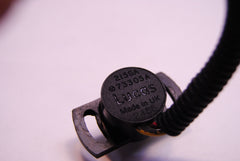or edit cart
87-88 Land Rover Range Rover Throttle Position Sensor For Lucas ECU 215SA 215SA 73305A

Range Rover Classic Cruise TPS
Up for sale is a Good used, working Range Rover classic Throttle position switch. Part numbers listed at top. We checked it's output with an ohm meter, and it works. A defective unit will cause odd engine operation, and a check engine light. This unit was pulled from a 1987 3.9, and has the adjustable TPS, and the "round" plug - please check your original part number to be sure if this is right for your car. I am pretty sure this is a 1 year part.
Throttle Position Sensor
The Throttle Position Sensor is mounted on the side of the plenum chamber inlet neck and is directly coupled to the throttle valve shaft. The potentiometer is a resistive device supplied with a voltage from the ECU. Movement of the throttle pedal causes the throttle valve to open, thus rotating the wiper arm within the potentiometer which in turn varies the resistance in proportion to the valve position. The ECU lengthens the injector open time when it detects a change in output voltage (rising) from the potentiometer. In addition, the ECU will weaken the mixture when it detects the potentiometer output voltage is decreasing under deceleration and will shorten the length of time the injectors are open. When the throttle is fully open, the ECU will detect the corresponding throttle potentiometer voltage and will apply full load enrichment. This is a fixed percentage and is independent of temperature. Full load enrichment is also achieved by adjusting the length of the injector open time. When the throttle is closed, overrun fuel cut off or idle speed control may be facilitated dependant on other inputs to the ECU. The throttle position sensor is designed to be self-adaptive. (At least in theory, adjustment is neither possible nor necessary. This is one small advantage of the 14CUX system over the 14CU system.)
To troubleshoot the Throttle Position Sensor, first disconnect system power and then disconnect the EFI Cable Harness from the ECU. Using an Ohmmeter, verify that resistance between terminals 3 and 25 is between 4000 and 6000 Ohms. Next, reconnect the EFI Cable Harness to the ECU, and turn the ignition key switch "on". Take voltmeter readings from pin 20 to ground. With the sensor in the throttle-closed position, you should read 0.085 to 0.545 volts. With the sensor in the throttle-open position, you should read 4.2 to 4.9 volts. In between these extremes, turning the throttle position sensor should produce a smooth sweep of voltage readings.
The Throttle Position Sensor on our example system is marked "215SA", "84925A", "Lucas", "Made in UK", and "2499". It has a 3-lead pigtail on it that's about 6" long, and the 3-pin connector on the end of the pigtail is marked "Rists". The three cables to the pigtail are color coded "yellow", "red" and "green" respectively.
Works fine and comes with a 30 day warranty. You can still buy these new, but at a cost of nearly $250 they are rather unaffordable. Thanks for looking and good luck!




